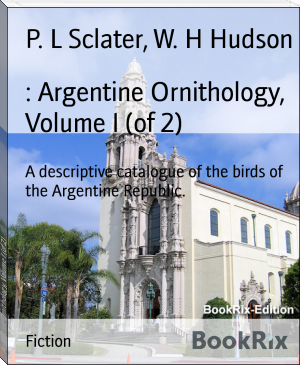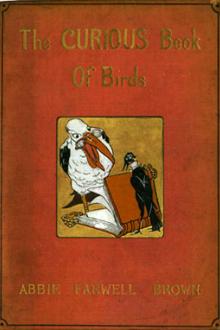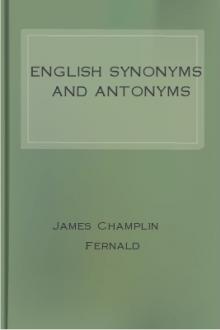: Argentine Ornithology, Volume I (of 2), P. L Sclater, W. H Hudson [best authors to read txt] 📗

- Author: P. L Sclater, W. H Hudson
Book online «: Argentine Ornithology, Volume I (of 2), P. L Sclater, W. H Hudson [best authors to read txt] 📗». Author P. L Sclater, W. H Hudson
_Female_ similar, but without the black on the face.
_Hab._ Brazil, Paraguay, and Northern Argentina.
This is again the only species of a North- and Central-American genus
which ranges so far south as Buenos Ayres. It visits us in summer, and
is found singly or in pairs in woods and large plantations. It feeds
both on the ground and in trees, and, while gleaning amongst the
leaves, frequently pauses to utter its loud cheerful song, composed
of seven or eight clear notes uttered with rapidity and emphasis.
19. BASILEUTERUS AURICAPILLUS, Sw. (GOLDEN-CROWNED WOOD-SINGER.)
+Basileuterus auricapillus+, _Sharpe, Cat. B._ x. p. 393.
+Basileuterus vermivorus+, _Scl. P. Z. S._ 1865, p. 283; _Scl. et
Salv. Nomencl._ p. 10; _White, P. Z. S._ 1882, p. 594 (Misiones).
_Description._--Above olive-yellow, lightest on the rump and upper
tail-coverts; tail-feathers ashy brown, with yellowish margins;
quills dusky; crown of head light orange-chestnut; nape and hind
neck pale ashy grey; on each side of the crown a broad black stripe
extending from the bill to the hind neck, also a streak of ashy
white above the eye; under surface bright yellow; axillaries and
under wing-coverts white; bill and feet brownish: total length 4·5
inches, wing 2·2, tail 2·05. _Female_ similar.
_Hab._ South America.
This species, which is widely spread over the northern portion of South
America, was found in Paraguay by Azara, and in the province of Misiones
by White.
20. SETOPHAGA BRUNNEICEPS, d'Orb. et Lafr. (BROWN-CAPPED WOOD-SINGER.)
+Setophaga brunneiceps+, _Burm. La-Plata Reise_, ii. p. 473
(Tucuman); _Scl. et Salv. Nomencl._ p. 11; _White, P. Z. S._
1882, p. 595 (Catamarca); _Sharpe, Cat. B._ x. p. 428.
_Description._--General colour dull olive-yellowish; wing-coverts
dark slaty grey; quills blackish; upper tail-coverts slaty grey,
washed with olive; tail-feathers blackish--the outer pair white, the
next pair white edged with black on the outer web, the third pair
with a large white mark at the end; crown of head deep chestnut;
neck slaty grey; under surface of body bright yellow; under tail-
and wing-coverts white: total length 5·0 inches, wing 2·45, tail
2·4. _Female_ similar.
_Hab._ Bolivia and Northern Argentina.
White obtained a pair of these birds on the Sierra of Totoral,
Catamarca, in July 1880. He describes them as quick in their movements
and difficult to shoot. The species was originally discovered by
d'Orbigny in Bolivia.
Fam. VII. (VIREONIDÆ, or GREENLETS.)
Three of the groups of the peculiar American family of Greenlets, allied
to our Shrikes, have representatives within the Argentine Republic. The
genera _Vireo_ and _Hylophilus_ both extend, each in the shape of one
of its South-Brazilian members, into the woodlands of the Paraná; while
_Cyclorhis_, another genus also widely spread over South and Central
America, has two representatives within our area. One of these latter is
well known in the neighbourhood of Buenos Ayres; the other is only found
in the extreme north of the Republic.
21. VIREOSYLVIA CHIVI (Vieill.). (CHIVI GREENLET.)
+Contramaestre gaviero+, _Azara, Apunt._ ii. p. 34. +Sylvia chivi+,
_Vieill. N. D._ xi. p. 174. +Vireosylvia chivi+, _Baird, Rev. A.
B._ p. 337; _Scl. et Salv. P. Z. S._ 1869, p. 160 (Buenos Ayres);
_Berl. et Jher. Zeitschr. ges. Orn._ 1885, p. 115. +Vireo chivi+,
_Gadow, Cat. B._ viii. p. 295.
_Hab._ South America, from Colombia down to Buenos Ayres.
A single specimen of this Greenlet was found in a collection made by Mr.
Haslehurst near Buenos Ayres. As the species occurs in Rio Grande do
Sul (_Berlepsch_) and Paraguay (_Azara_), its occasional appearance in
Eastern Argentina is quite probable. Whether the bird is really distinct
from the widespread _Vireo olivaceus_ seems to be a question which is
not yet finally settled.
Azara, describing this species, says it is one of the commonest in
deep woods, where it moves about among the terminal twigs, without
ever rising to the tops of the trees or flying down to the brush or the
ground. It is active, and extremely restless in manner; and in searching
after and taking the small insects and spiders on which it lives
it climbs about the twigs, assuming every position, and frequently
suspending itself, head downwards, by its feet. It has a full
pleasing voice of considerable power, heard incessantly in the woods,
particularly in the love-season. The nest is a slender beautiful
structure, even surpassing that of the Humming-birds, constructed of
thin dry leaves outside, smoothly attached to the rest with spiders'
webs, while the inside is formed of fine fibres and cotton.
22. HYLOPHILUS PŒCILOTIS, Max. (BROWN-HEADED WOOD-BIRD.)
+Hylophilus pœcilotis+, _Scl. et Salv. Nomencl._ p. 12; _Scl.
Ibis_, 1881, p. 300; _White, P. Z. S._ 1882, p. 595 (Misiones);
_Gadow, Cat. B._ viii. p. 308.
_Description._--Crown of head and nape rich rufous-brown; all the
rest of the upper parts, including the entire tail and wing-coverts
and the outer webs of the remiges, rich olive-green; cheeks and
upper throat whitish; ear-coverts blackish, with white central
streaks; under wing-coverts, axillaries, inner margin of remiges,
and under tail-coverts lemon-yellow; rest of underparts dull yellow,
washed with olive on the breast and flanks, and inclining to pale
ochreous on the abdomen; bill dark flesh-colour; feet hazel: total
length 4·5 inches, wing 2·2, tail 2·2. _Female_ similar.
_Hab._ Southern Brazil, Paraguay, and Northern Argentina.
This South-Brazilian species was met with by White near San Javier, in
the province of Misiones, in June 1881.
23. CYCLORHIS OCHROCEPHALA. (OCHRE-HEADED GREENLET-SHRIKE.) [Plate III. Fig. 1.]
+Cyclorhis viridis+, _Burm. La-Plata Reise_, ii. p. 472; _Scl. et
Salv. Nomencl._ p. 13; _Durnford, Ibis_, 1878, p. 58 (Punta
Lara); _White, P. Z. S._ 1882, p. 595 (Buenos Ayres); _Gadow,
Cat. B._ viii. p. 318. +Cyclorhis ochrocephala+, _Tsch. Arch. f.
Nat._ 1845, pt. i. p. 362; _Berl. et Jher. Zeitschr. ges. Orn._
1885, p. 116.
_Description._--Above olive-green; cap brownish ochraceous, more or
less rufescent; front and superciliaries chestnut-red; sides of head
clear grey, beneath pale buff; breast and flanks yellow; throat
greyish white; bill reddish grey, feet grey; eye reddish: total
length 7·0 inches, wing 3·4, tail 2·8. _Female_ similar.
_Hab._ Middle districts of Argentina.
This species is not uncommon in the woods along the shores of the Plata,
and may be easily known to any person penetrating them by its loud
"cheerful soliloquy," for that phrase of Mr. Barrows, the North-American
writer on birds, well describes the artless, light-hearted song which it
utters at intervals while it roams about in the deep foliage, and which
reminds one of the careless whistling of a boy, whistling merely to
express his gaiety, but without having any particular tune in his mind.
It is migratory, and extends its range south of Buenos Ayres.
24. CYCLORHIS ALTIROSTRIS, Salvin. (DEEP-BILLED GREENLET-SHRIKE.) [Plate III. Fig. 2.]
+Cyclorhis altirostris+, _Salv. Ibis_, 1880, p. 352; _Gadow, Cat. B._
viii. p. 319. +Cyclorhis viridis+, _Barrows, Bull. Nutt. Orn.
Cl._ viii. p. 88 (Concepcion, Entrerios); _Berl. et Jher.
Zeitschr. ges. Orn._ 1885, p. 116.
_Description._--Above olive-green; head more or less rufescent;
front and superciliaries chestnut-red; sides of head grey, beneath
pale ochraceous; breast and sides yellow; throat greyish; bill short
and thick, pale reddish, with a black blotch at the base of the
lower mandible;





Comments (0)